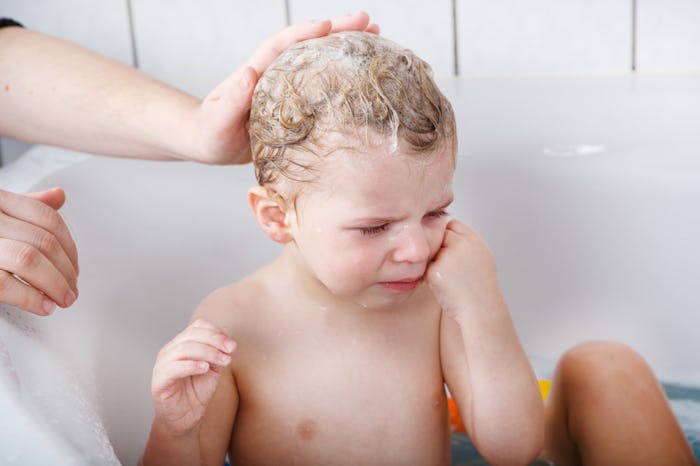Why do kids get so sticky? When it comes to toddlers, stickiness seems like a constant state of being, which is one reason why many moms of toddlers look forward to bath time. Bath time means the stickiness will subside (for now), and that it’s almost mom (read: wine) time. You’ve had a long day answering "Why," your kid probably smells like feet, and there’s also some weird stickiness on your kid’s hands and hair. No judgement. But bath time isn't always easy and as your kid throws a fit, you're probably wondering, "Why does my toddler hate baths?"
Kate Orson, a Hand-in-Hand Parenting instructor and author of Tears Heal: How to Listen to Our Children, says to Romper in an email, "What often happens with toddlers is when they have upset feelings, they often project those feelings onto an everyday situation such as taking a bath or going in a car seat. A toddler who is free of upset is probably going to love splashing around and having a nice bath, unless they are overtired, and just to want to cuddle up and go to sleep."
Postpartum doula and certified lactation counselor Liza Maltz says in an email to Romper, "I think kids hate bath time, because they know it means bedtime is soon."
"If you make it fun with some cool cups (toddlers love cups), bubbles, and bath crayons, you’re pretty much going to have a kid that loves baths," Maltz says. "Make it fun, put a large rubber bath mat across the bottom of the tub, and let them play."
So what other ways can you get your kid to relax when it’s bath time, and even, dare I say, enjoy it? Orson suggests trying giggle parenting. "Basically it involves using laughter to dissolve tension and upset, and [it helps] to shift your child's mood," Orson says. "For example, you might run a bath, and then tell them it's time to get in, but instead of getting them in, you 'accidentally' put your own toe or arm in the bath."
"You then act confused as you realize your 'mistake,'" she says. "Or you get some cuddly toys, and try to put them in the bath, and then say something like, 'Oh no, that's not right, I meant to put (child's name) in the bath, not this cuddly toy.'"
Orson says when parents pretend to make these kind of "mistakes" and laugh about those mistakes, they’ll hopefully make the child laugh and connect with them. "It eases the tension, and makes your child feel more comfortable with having a bath," she adds.
On the Baby Center community forum, many moms suggested making sure the water was warm enough, because sometimes the child is cold and can’t express that to you. You should also try to use a soothing voice, smile a lot, and not let them see your frustration. If your kid sees you’re having a good time, they probably will too, eventually. Their emotions may reflect what they sense your emotions are at the time.
Additional advice included making sure the child wasn’t hungry or overtired at bath time, and bathing with your toddler also works for some families.
Bath time should be a relaxing close to both your day and your child’s. Whether you have to make jokes, buy special toys, or just hop on in the tub with them, it’s worth it to get rid of the feet smell, and to temporarily get rid of the stickiness — which gets you one step closer to that glass of wine or cup of tea tonight, before starting over again tomorrow.
